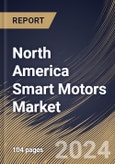Smart motors play a crucial role in industrial automation systems, powering machinery, conveyors, robotic arms, and other equipment essential for manufacturing processes. They provide precise control over motion, speed, and torque, enabling efficient production, improved accuracy, and increased productivity on assembly lines and manufacturing floors. Heating, ventilation, and air conditioning (HVAC) systems in commercial and residential buildings utilize smart motors for efficient operation and energy management. It enables variable speed control, allowing HVAC systems to adjust airflow and temperature levels based on real-time demand, environmental conditions, and occupancy patterns, resulting in energy savings and enhanced comfort.
Additionally, wind turbines and solar panels leverage smart motors for precise tracking, positioning, and orientation control to maximize energy harvesting from renewable sources. It enables solar trackers to follow the sun’s movement throughout the day, optimizing solar panel efficiency. At the same time, wind turbines use smart motors to adjust blade pitch and rotor speed for optimal energy production in varying wind conditions. Furthermore, they are being incorporated into vacuum cleaners, refrigerators, dishwashers, and washing machines, among other home appliances, to provide increased performance, quieter operation, and energy economy. It enables variable speed control and adaptive load balancing in appliances like washing machines, reducing energy consumption and water usage while ensuring thorough cleaning.
The growing mining sector in Mexico expands the market potential for smart motors. As mining operations expand and new projects are undertaken, there’s a corresponding increase in the demand for smart motors across various applications within the mining industry. According to the International Trade Administration data, the value of Mexico’s mining industry in 2022 was USD 3.3 billion. About half of Mexico’s mining production consists of extracting precious metals, with the remaining output composed of 40 percent non-ferrous, six percent metallurgy, and seven percent non-metallic ores. In 2022, mining production reached USD 16.16 billion. In conclusion, the expansion of the mining sector and rising investments in the healthcare sector is propelling the market growth in the region.
The US market dominated the North America Smart Motors Market, by Country in 2022, and would continue to be a dominant market till 2030; thereby, achieving a market value of $695.5 Million by 2030. The Canada market is experiencing a CAGR of 8.5% during (2023 - 2030). Additionally, The Mexico market would exhibit a CAGR of 7.5% during (2023 - 2030).
Based on End-use, the market is segmented into Industrial, Automotive, Consumer Electronics, Aerospace & Defense, and Others. Based on Product, the market is segmented into 24V, 48V & above, 18V, and 36V. Based on countries, the market is segmented into U.S., Mexico, Canada, and Rest of North America.
List of Key Companies Profiled
- Rockwell Automation, Inc.
- Moog, Inc.
- Fuji Electric Co. Ltd.
- ABB Ltd.
- Siemens AG
- Schneider Electric SE
- General Electric Company
- Dunkermotoren GmbH (Ametek, Inc.)
- RobotShop Inc.
- Roboteq, Inc. (Nidec Motor Corporation)
Market Report Segmentation
By End-use- Industrial
- Automotive
- Consumer Electronics
- Aerospace & Defense
- Others
- 24V
- 48V & above
- 18V
- 36V
- US
- Canada
- Mexico
- Rest of North America
Table of Contents
Companies Mentioned
- Rockwell Automation, Inc.
- Moog, Inc.
- Fuji Electric Co. Ltd.
- ABB Ltd.
- Siemens AG
- Schneider Electric SE
- General Electric Company
- Dunkermotoren GmbH (Ametek, Inc.)
- RobotShop Inc.
- Roboteq, Inc. (Nidec Motor Corporation)
Methodology

LOADING...








